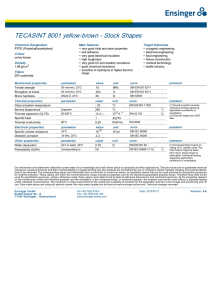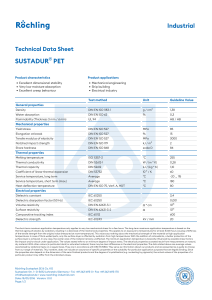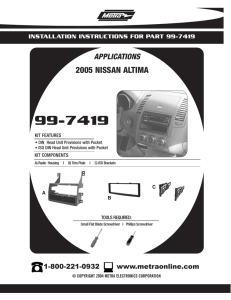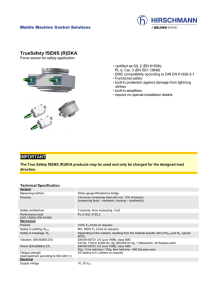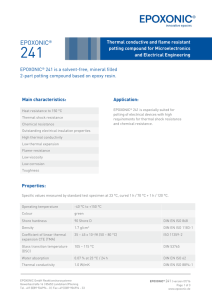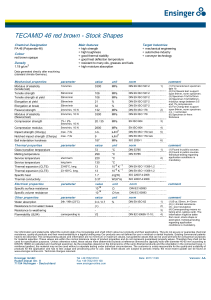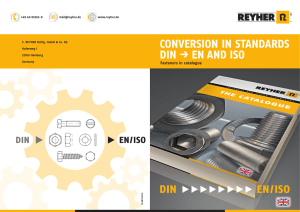Data sheet SUSTAABS
advertisement
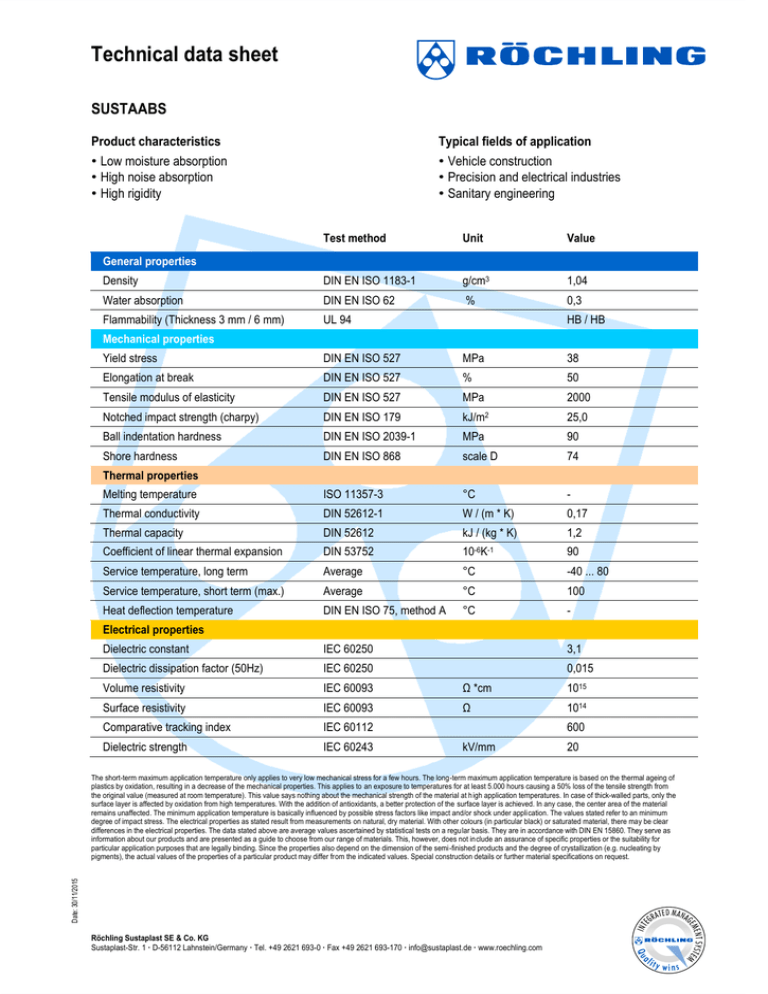
Technical data sheet SUSTAABS Product characteristics Typical fields of application • Low moisture absorption • High noise absorption • High rigidity • Vehicle construction • Precision and electrical industries • Sanitary engineering Test method Unit Value Density DIN EN ISO 1183-1 g/cm3 1,04 Water absorption DIN EN ISO 62 % 0,3 Flammability (Thickness 3 mm / 6 mm) UL 94 General properties HB / HB Mechanical properties Yield stress DIN EN ISO 527 MPa 38 Elongation at break DIN EN ISO 527 % 50 Tensile modulus of elasticity DIN EN ISO 527 MPa 2000 Notched impact strength (charpy) DIN EN ISO 179 kJ/m2 25,0 Ball indentation hardness DIN EN ISO 2039-1 MPa 90 Shore hardness DIN EN ISO 868 scale D 74 Melting temperature ISO 11357-3 °C - Thermal conductivity DIN 52612-1 W / (m * K) 0,17 Thermal capacity DIN 52612 kJ / (kg * K) 1,2 Coefficient of linear thermal expansion DIN 53752 10-6K-1 90 Service temperature, long term Average °C -40 ... 80 Service temperature, short term (max.) Average °C 100 Heat deflection temperature DIN EN ISO 75, method A °C - Thermal properties Electrical properties Dielectric constant IEC 60250 3,1 Dielectric dissipation factor (50Hz) IEC 60250 0,015 Volume resistivity IEC 60093 Ω *cm 1015 Surface resistivity IEC 60093 Ω 1014 Comparative tracking index IEC 60112 Dielectric strength IEC 60243 600 kV/mm 20 Date: 30/11/2015 The short-term maximum application temperature only applies to very low mechanical stress for a few hours. The long-term maximum application temperature is based on the thermal ageing of plastics by oxidation, resulting in a decrease of the mechanical properties. This applies to an exposure to temperatures for at least 5.000 hours causing a 50% loss of the tensile strength from the original value (measured at room temperature). This value says nothing about the mechanical strength of the material at high application temperatures. In case of thick-walled parts, only the surface layer is affected by oxidation from high temperatures. With the addition of antioxidants, a better protection of the surface layer is achieved. In any case, the center area of the material remains unaffected. The minimum application temperature is basically influenced by possible stress factors like impact and/or shock under application. The values stated refer to an minimum degree of impact stress. The electrical properties as stated result from measurements on natural, dry material. With other colours (in particular black) or saturated material, there may be clear differences in the electrical properties. The data stated above are average values ascertained by statistical tests on a regular basis. They are in accordance with DIN EN 15860. They serve as information about our products and are presented as a guide to choose from our range of materials. This, however, does not include an assurance of specific properties or the suitability for particular application purposes that are legally binding. Since the properties also depend on the dimension of the semi-finished products and the degree of crystallization (e.g. nucleating by pigments), the actual values of the properties of a particular product may differ from the indicated values. Special construction details or further material specifications on request. Röchling Sustaplast SE & Co. KG Sustaplast-Str. 1 · D-56112 Lahnstein/Germany · Tel. +49 2621 693-0 · Fax +49 2621 693-170 · info@sustaplast.de · www.roechling.com
